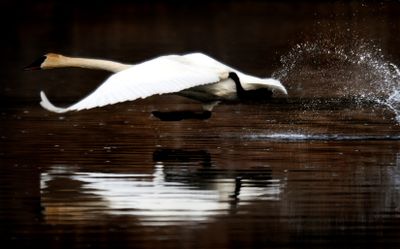Solo’s saga detailed
Senior swan a fascinating factor in Turnbull’s trumpeter history

With thousands of tundra swans flooding through the region on their spring migration, a birdwatching spotlight still shines on a single endangered trumpeter swan that’s become an icon at Turnbull National Wildlife Refuge.
The elegant male trumpeter swan is likely the refuge’s elder seasonal wildlife resident and one of the oldest documented anywhere among his endangered species.
A typographical error on the bird’s age at the end of my story last week gave me an excuse to dig a little deeper into the history of Solo, the male trumpeter that’s been returning to Turnbull each March for at least three decades.
Judging from reader calls and e-mails, you’re also interested in the details.
Mike Rule, refuge biologist, cruised refuge files to help compile this background and update.
Solo has had his ups and downs. He soared with the success of raising several families – he even tried to incubate a clutch of Canada geese eggs after he ran the parents out of his territory.
Solo and his mate raised Turnbull’s last nest of trumpeter cygnets in 1987.
Solo lost his mate, apparently to a predator, on her Winslow Pool nesting island in 1988.
Trumpeter swans pair for life, but if a mate is killed, they often will look for a new companion.
Solo has lured in several new prospects over the years, but they have not produced young.
While Solo still has the swagger to attract a mate and the vinegar to defend his territory, he may not have viable tools to produce young.
“He might be too old,” Rule said.
A normal lifespan for a trumpeter swan is 20-30 years. Banding studies have documented Solo to be at least 28 years old. However, breeding surveys give Rule evidence that he’s at least 33.
Solo was banded in 1983 and recorded as a bird that was at least 3 years old. But Rule said he has records indicating Solo was of breeding age and paired with a female that was collared before producing three cygnets in 1979.
“Based on that – swans don’t breed until they are at least 4 years old and more commonly at the age of 5 – he might be one of the cygnets produced in 1974,” Rule said.
On the other hand, there’s a chance Solo could be from among the first trumpeters introduced to the refuge as cygnets.
Records show that six hand-reared cygnets were released at Turnbull in an endangered species recovery effort in 1963. Another 11 cygnets were delivered to the refuge in 1965, followed by 20 brought in for the last re-introduction effort in 1966.
If Solo is one of the original Turnbull cygnets – this was the belief of Jim Reese, a biologist at the refuge in the late ’70s – the cob could be on the verge of 46.
Turnbull’s first successful trumpeter swan nesting was documented in 1967.
Trumpeter pairs successfully mated and nested 56 times at Turnbull from 1964 through 1988. Those 56 nests produced 122 cygnets. Of those, 83 survived to flight age.
The last successful nesting year was 1987.
Solo apparently had a role in producing a third or more of Turnbull’s total trumpeter crop.
A cob usually replaces its lost mate with a younger pen and returns to the former nesting territory.
“He’s been back every year, several times with females, but there’s never been another successful nesting since the three cygnets in ’87,” Rule said.
Turnbull continues to be Solo’s home as soon as the ice comes off in March. He stays until freeze-up. Rule believes it was Solo who returned during the first week of March, as he always has within a day or so after the ice leaves enough open water for a landing near the refuge headquarters.
The recent big chill sent him packing, possible to open waters of the Spokane River, but last week, two trumpeter swans showed up at Turnbull, hanging out mostly at Pine Lake.
It could be a pair or simply two swans hanging out temporarily. The sexes haven’t been confirmed.
“Solo lost his bands a few years ago,” Rule said. “We’ll know whether it’s him out there by his routine. If there’s a swan that calls and flies up and down Pine Creek every morning after April 15, after the migrant swans leave, it’s probably him.
“Only twice before has a swan stayed longer than April 15, and that was likely because (Solo) was here to lure them. When he goes, I doubt any other swan will stay through the summer.”
It’s Solo’s relentless presence that may have discouraged other swans from adopting his territory.
“He even defends Winslow Pool against geese,” Rule said. “Male swans don’t usually sit on nests, but he incubated goose eggs after driving off the parents one year.”
Solo and a mate built nesting platforms between 1994 and 1996, but they didn’t lay eggs.
“That could have been the female’s problem,” Rule said. “Even if Solo is too old to breed, she still should have laid unfertilized eggs.”
That attempt in 1996 was Solo’s last venture to the brink of fatherhood.
“He’s an interesting bird, and we still don’t know exactly where he goes for winter, although judging how quickly he’s here at ice out, it’s probably not too far,” Rule said.
“But I’m reluctant to put another collar on him. Trapping is traumatic, since you have to wait for molt and chase him down in a boat.
“After all these years, I don’t want to be the biologist who gives Solo a heart attack.”